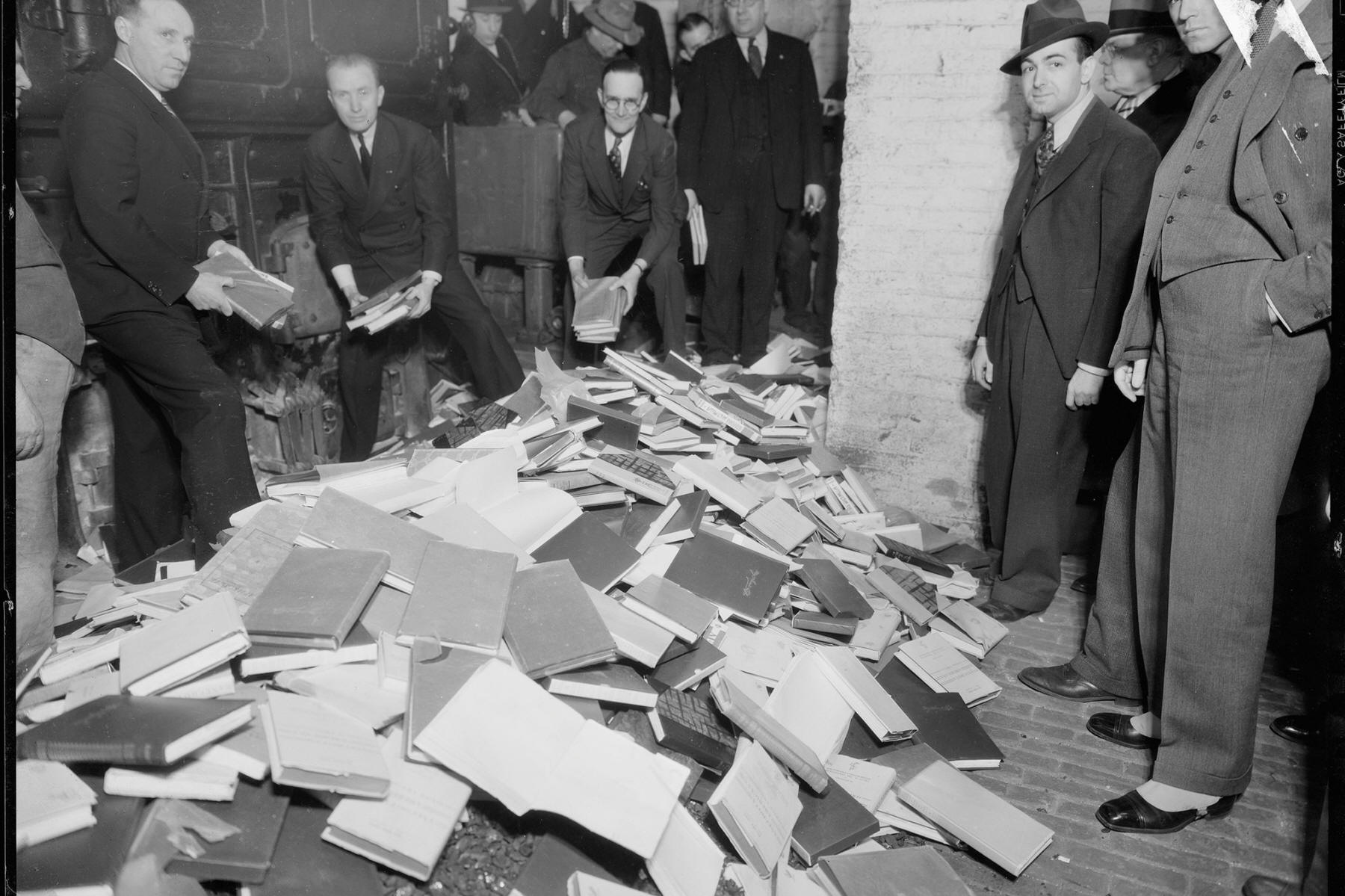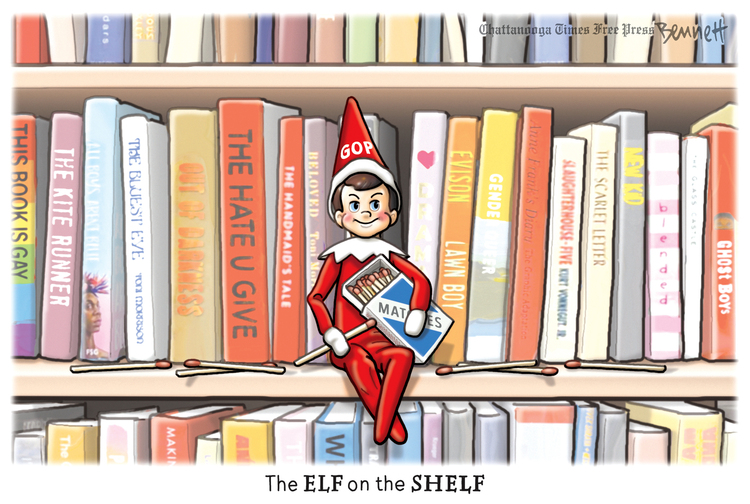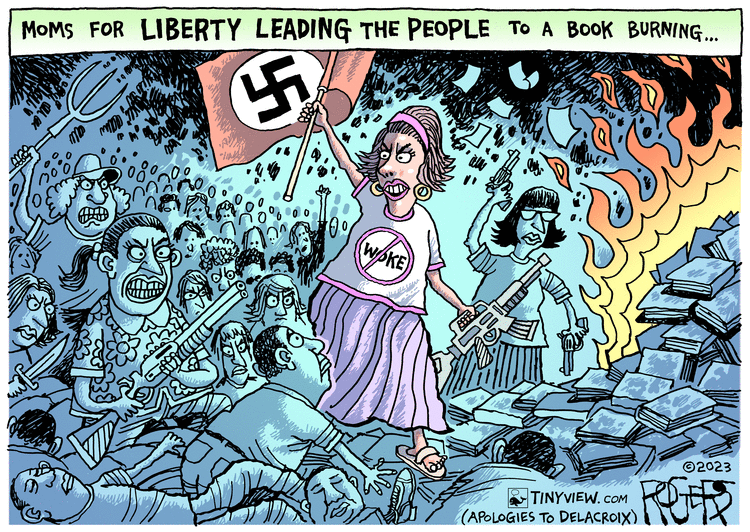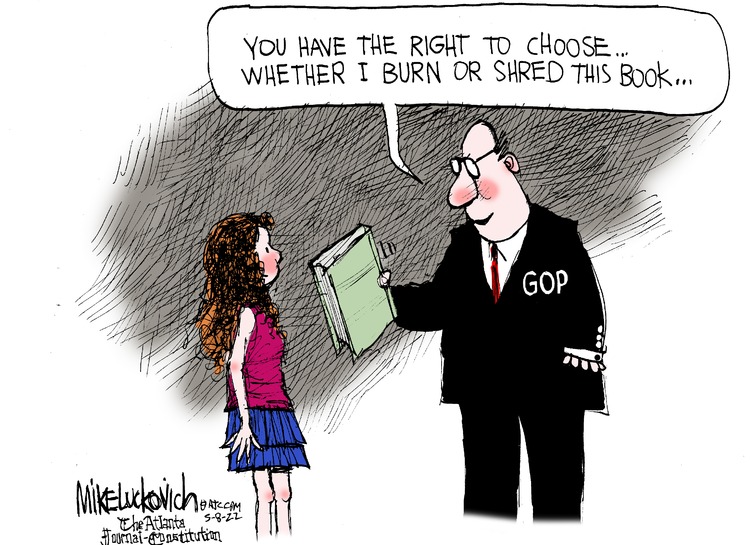|
Vocapedia >
Arts >
Books > Censorship

Books considered indecent
being destroyed in the furnace room of
Police Headquarters
in Manhattan in 1935.
Photograph: New York City Municipal Archives
Dusting Off a Police Trove of Photographs to
Rival Weegee’s
NYT
MARCH 20, 2015
https://www.nytimes.com/2015/03/21/
nyregion/reaching-into-the-past-the-police-dust-off-a-photographic-trove-to-rival-weegees.html

Clay Bennett
political cartoon
GoComics
November 26, 2023
https://www.gocomics.com/claybennett/2023/11/26
censor
USA
https://www.npr.org/2023/09/20/
1200647985/book-bans-libraries-schools
censor
USA
https://www.npr.org/2024/01/29/
1222539335/banned-books-high-school
http://www.nytimes.com/2012/02/23/
arts/barney-rosset-grove-press-publisher-dies-at-89.html
censoring
censorship
UK / USA
https://www.gocomics.com/claybennett/2023/11/26
https://www.npr.org/2022/04/26/
1094807686/texas-library-book-ban-lawsuit
http://www.nytimes.com/2014/06/25/
books/kevin-birminghams-book-on-ulysses-and-censorship.html
http://www.nytimes.com/2013/04/24/us/
edward-de-grazia-lawyer-who-fought-censorship-is-dead-at-86.html
http://www.nytimes.com/2012/02/23/
arts/barney-rosset-grove-press-publisher-dies-at-89.html
http://www.guardian.co.uk/books/2008/sep/29/
philip.pullman.amber.spyglass.golden.compass.banned
clampdown on books
USA
https://www.npr.org/2022/05/05/
1096830688/nashville-tennessee-banned-books-library-card

Rob Rogers
political cartoon
GoComics
July 18, 2023
https://www.gocomics.com/robrogers/2023/07/18
Related
https://en.wikipedia.org/wiki/Liberty_Leading_the_People
ban USA
https://www.npr.org/2022/04/26/
1094740651/florida-man-asks-schools-to-ban-the-bible-
following-the-states-efforts-to-remove
https://www.npr.org/sections/thetwo-way/2013/09/20/
224360854/book-news-north-carolina-county-bans-the-invisible-man
be banned
USA
https://www.nytimes.com/2024/05/01/
books/booksupdate/book-ban-chocolate-war-cormier-.html
https://www.npr.org/2022/10/25/
1130433140/banned-books-all-boys-arent-blue-george-johnson-lgbtq-ya
banned books
UK
http://www.theguardian.com/books/booksblog/gallery/2013/sep/27/
banned-books-readers-censored-pictures
http://www.guardian.co.uk/books/2008/oct/02/
steinbeck.joyce.lawrence.sewell.voltaire
ban UK
https://www.theguardian.com/books/2011/apr/12/
brave-new-world-challenged-books
ban USA
https://www.npr.org/2023/06/02/
1179906120/utah-bible-book-challenge
book bans USA
2024
https://www.npr.org/2024/06/30/
nx-s1-5024108/lgbtq-book-bans-san-francisco-store-ships-books-to-where-they-are-banned
https://www.nytimes.com/2024/05/10/
books/lauren-groff-bookstore-lynx.html
2023
https://www.npr.org/2023/05/18/
1176879171/florida-book-ban-lawsuit
banned books
USA
2024
https://www.npr.org/2024/01/29/
1222539335/banned-books-high-school
2022
https://www.npr.org/2022/10/25/
1130433140/banned-books-all-boys-arent-blue-george-johnson-lgbtq-ya
https://www.npr.org/2022/09/01/
1120576731/an-oklahoma-teacher-gave-her-students-access-to-banned-books-
now-shes-under-scru
https://www.npr.org/2022/05/05/
1096830688/nashville-tennessee-banned-books-library-card
https://www.npr.org/2022/04/15/
1093095474/new-york-public-library-makes-banned-books-available-for-free
https://www.npr.org/2022/03/31/
1089726765/these-kids-authors-are-telling-the-stories-of-trans-youth-
book-bans-wont-stop-th
2021
https://www.npr.org/2021/11/22/
1058107484/banned-books-list-talk-to-kids
https://www.npr.org/2021/11/13/
1055524205/more-republican-leaders-try-to-ban-books-on-race-lgbtq-issues
Brooklyn Public Library's Books Unbanned project
USA
https://www.bkly
https://www.npr.org/2022/09/01/
1120576731/an-oklahoma-teacher-gave-her-students-access-to-banned-books-
now-shes-under-scru
bans on books
about race and LGBTQ+
identities USA
https://www.npr.org/2022/03/31/
1089726765/these-kids-authors-are-telling-the-stories-of-trans-youth-
book-bans-wont-stop-th
book bans
USA
https://www.npr.org/2022/04/26/
1094807686/texas-library-book-ban-lawsuit
https://www.npr.org/2022/03/31/
1089726765/these-kids-authors-are-telling-the-stories-of-trans-youth-
book-bans-wont-stop-th
schoolbook bans
USA
https://www.npr.org/2023/09/26/
1201804972/california-gov-newsom-barring-book-bans-race-lgbtq

Mike Luckovich
political cartoon
GoComics
May 08, 2022
https://www.gocomics.com/mikeluckovich/2022/05/08
burn books
USA
https://www.gocomics.com/mikeluckovich/
2022/05/08
https://www.npr.org/2009/07/30/
106929166/reimagining-fahrenheit-451-as-a-graphic-novel
book burners
USA
http://www.nytimes.com/2015/03/11/nyregion/
6-decades-on-a-patriotic-plea-still-resonates.html
1953 >
USA > Ray Bradbury's 'Fahrenheit 451' UK
/ USA
https://en.wikipedia.org/wiki/
Fahrenheit_451
https://www.npr.org/2018/05/18/
611955887/heavy-handed-faranheit-451-
lacks-the-poetry-of-ray-bradbury-s-original
https://www.theguardian.com/film/2018/may/13/
fahrenheit-451-review-michael-b-jordan-adaptation-fails-to-catch-fire
https://www.npr.org/sections/thetwo-way/2012/06/06/
154422373/ray-bradbury-author-of-fahrenheit-451-and-other-classics-dies
https://www.theguardian.com/books/2011/sep/29/
fahrenheit-451-reading-the-film
https://www.npr.org/2009/07/30/
106929166/reimagining-fahrenheit-451-as-a-graphic-novel
https://www.theguardian.com/books/booksblog/2008/jan/15/
burningstillfahrenheit451
https://www.npr.org/templates/story/
story.php?storyId=1464578 - October 13, 2003
book purge
USA
http://www.nytimes.com/2015/03/11/nyregion/
6-decades-on-a-patriotic-plea-still-resonates.html
Corpus of news articles
Arts > Books > Ban, Censorship
A San Francisco store
is shipping LGBTQ+ books to places
where they are banned
June 30, 2024
NPR
By The Assoxiated Press
SAN FRANCISCO — In an increasingly divisive
political sphere, Becka Robbins focuses on what she knows best — books.
Operating out of a tiny room in Fabulosa Books in San Francisco's Castro
District, one of the oldest gay neighborhoods in the United States, Robbins uses
donations from customers to ship boxes of books across the country to groups
that want them.
In an effort she calls "Books Not Bans," she sends titles about queer history,
sexuality, romance and more — many of which are increasingly hard to come by in
the face of a rapidly growing movement by conservative advocacy groups and
lawmakers to ban them from public schools and libraries.
"The book bans are awful, the attempt at erasure," Robbins said. She asked
herself how she could get these books into the hands of the people who need them
the most.
Beginning last May, she started raising money and
looking for recipients. Her books have gone to places like a pride center in
west Texas and an LGBTQ-friendly high school in Alabama.
Customers are especially enthusiastic about helping Robbins send books to places
in states like Florida, Texas and Oklahoma, often writing notes of support to
include in the packages. Over 40% of all book bans from July 2022 to June 2023
were in Florida, more than any other state. Behind Florida are Texas and
Missouri, according to a report by PEN America, a nonprofit literature advocacy
group.
Book bans and attempted bans have been hitting record highs, according to the
American Library Association. And the efforts now extend as much to public
libraries as school libraries. Because the totals are based on media accounts
and reports submitted by librarians, the association regards its numbers as
snapshots, with many bans left unrecorded.
PEN America's report said 30% of the bans include characters of color or discuss
race and racism, and 30% have LGBTQ+ characters or themes.
The most sweeping challenges often originate with conservative organizations,
such as Moms for Liberty, which has organized banning efforts nationwide and
called for more parental control over books available to children.
Moms for Liberty is not anti-LGBTQ+, co-founder
Tiffany Justice has told The Associated Press. But about 38% of book challenges
that "directly originated" from the group have LGBTQ+ themes, according to the
library association's Office for Intellectual Freedom. Justice said Moms for
Liberty challenges books that are sexually explicit, not because they cover
LGBTQ+ topics.
Among those topping banned lists have been Maia Kobabe's "Gender Queer," George
Johnson's "All Boys Aren't Blue" and Nobel laureate Toni Morrison's "The Bluest
Eye."
Robbins said it's more important than ever to makes these kinds of books
available to everyone.
"Fiction teaches us how to dream," Robbins said. "It teaches us how to connect
with people who are not like ourselves, it teaches us how to listen and
emphasize."
She's sent 740 books so far, with each box worth $300 to $400, depending on the
titles.
At the new Rose Dynasty Center in Lakeland, Fla.,
the books donated by Fabulosa are already on the shelves, said Jason DeShazo, a
drag queen known as Momma Ashley Rose who runs the LGBTQ+ community center.
DeShazo is a family-friendly drag performer and has long hosted drag story times
to promote literacy. He uses puppets to address themes of being kind, dealing
with bullies and giving back to the community.
DeShazo hopes to provide a safe space for events, support groups and health
clinics, and to build a library of banned books.
"I don't think a person of color should have to search so hard for an amazing
book about history of what our Black community has gone through," DeShazo said.
"Or for someone who is queer to find a book that represents them."
Robbins' favorite books to send are youth adult queer romances, a rapidly
growing genre as conversations about LGBTQ+ issues have become much more
mainstream than a decade ago.
"The characters are just like regular kids — regular people who are also queer,
but they also get to fall in love and be happy," Robbins said.
A San Francisco store is shipping LGBTQ+ books to
places where they are banned,
NPR,
JUNE 30, 2024
https://www.npr.org/2024/06/30/
nx-s1-5024108/lgbtq-book-bans-san-francisco-store-ships-books-to-where-they-are-banned
Defied Censors,
Making Racy a Literary Staple
February 22, 2012
The New York Times
By DOUGLAS MARTIN
Barney Rosset, the flamboyant, provocative publisher who helped
change the course of publishing in the United States, bringing masters like
Samuel Beckett to Americans’ attention under his Grove Press imprint and winning
celebrated First Amendment slugfests against censorship, died on Tuesday in
Manhattan. He was 89.
His son Peter said he died after a double-heart-valve replacement.
Over a long career Mr. Rosset championed Beat poets, French Surrealists, German
Expressionists and dramatists of the absurd, helping to bring them all to
prominence. Besides publishing Beckett, he brought early exposure to European
writers like Eugène Ionesco and Jean Genet and gave intellectual ammunition to
the New Left by publishing Che Guevara, Ho Chi Minh and “The Autobiography of
Malcolm X.”
Most of all, beginning in high school, when he published a mimeographed journal
titled “The Anti-Everything,” Mr. Rosset, slightly built and sometimes
irascible, savored a fight.
He defied censors in the 1960s by publishing D. H. Lawrence’s “Lady Chatterley’s
Lover” and Henry Miller’s “Tropic of Cancer,” ultimately winning legal victories
that opened the door to sexually provocative language and subject matter in
literature published in the United States. He did the same thing on movie
screens by importing the sexually frank Swedish film “I Am Curious (Yellow).”
Mr. Rosset called Grove “a breach in the dam of American Puritanism.”
Beyond being sued scores of times, he received death threats. Grove’s office in
Greenwich Village was bombed.
In 2008 the National Book Foundation honored him as “a tenacious champion for
writers who were struggling to be read in America.”
Other mentions were less lofty. Life magazine in 1969 titled an article about
him “The Old Smut Peddler.” That same year a cover illustration for The Saturday
Evening Post showed him climbing out of a sewer.
Mr. Rosset was hardly the only publisher to take risks, lasso avant-garde
authors or print titillating material. But few so completely relied on
seat-of-the-pants judgment. Colleagues said he had “a whim of steel.”
“He does everything by impulse and then figures out afterward whether he’s made
a smart move or was just kidding,” Life said.
Simply put, Mr. Rosset liked what he liked. In an interview with Newsweek in
2008, he said he printed erotica because it “excited me.”
A Counterculture Voice
In 1957 he helped usher in a new counterculture when he began the literary
journal Evergreen Review, originally a quarterly. (It later became a bimonthly
and then a glossy monthly.) The Review, published until 1973, sparkled with
writers like Beckett, who had a story and poem in the first issue, and Allen
Ginsberg, whose poem “Howl” appeared in the second. There were also lascivious
comic strips.
Barnet Lee Rosset Jr. was born into wealth in Chicago on May 28, 1922. His
father owned banks, and though the elder Mr. Rosset had conservative views, he
sent his son to the liberal Francis W. Parker School. The school was so
progressive, Mr. Rosset told The New York Times in 2008, that teachers arranged
for students to sleep with one another.
“I’m half-Jewish and half-Irish,” he told The Associated Press in 1998, “and my
mother and grandfather spoke Gaelic. From an early age my feelings made the
I.R.A. look pretty conservative. I grew up hating fascism, hating racism.”
He called his 17th year his happiest. He was class president, football star,
holder of a state track record and, he said, boyfriend of the school’s
best-looking girl. He circulated a petition demanding that John Dillinger be
pardoned. In 1940 he went to Swarthmore College, which he disliked because class
attendance was compulsory. After a year he transferred to the University of
Chicago for a quarter, then to the University of California, Los Angeles. A few
months later he joined the Army and served in a photographic unit in China.
After the war he earned a bachelor’s degree in philosophy at the University of
Chicago. He joined the Communist Party but soon rejected it, he said, after
visiting Eastern Europe.
Initially interested in film, he spend $250,000 of his family’s fortune in New
York to produce a documentary, “Strange Victory,” about the prejudice that black
veterans faced when they returned from World War II. The film was poorly
received, and afterward he headed for Paris with Joan Mitchell, a former high
school classmate who became an acclaimed Abstract Expressionist painter. They
married in 1949 and returned to New York, where he studied literature at the New
School for Social Research, earning another bachelor’s degree in 1952.
Told that a small press on Grove Street in Greenwich Village was for sale, he
bought it in 1951 for $3,000. His goal almost from the beginning was to publish
Miller’s “Tropic of Cancer,” an autobiographical, sexually explicit novel that
had been published in Paris in 1934 and long been banned in the United States.
But he decided first to publish “Lady Chatterley’s Lover,” which had originally
appeared in Italy in 1928. He theorized that though it was also banned in the
United States, it commanded greater respect than Miller’s book.
Arthur E. Summerfield, the postmaster general, lived up to Mr. Rosset’s
expectations and barred the book from the mails — Grove’s means of distribution
— in June 1959, calling it “smutty.” But a federal judge in Manhattan lifted the
ban, ruling that the book had redeeming merit. The reasoning pleased Mr. Rosset
less than the result: as a foe of censorship he was an absolutist.
A Free Speech Advocate
“If you have freedom of speech, you have freedom of speech,” he said. He faced a
new round of censorship after buying the rights to “Tropic of Cancer” for
$50,000 in 1961, the agreement having been struck by Miller and Mr. Rosset over
a game of table tennis. Mr. Summerfield again imposed a ban but lifted it before
it could be challenged in court.
Nevertheless, the book was attacked in more than 60 legal cases seeking to ban
it in 21 states, and Mr. Rosset was arrested and taken before a Brooklyn grand
jury, which decided against an indictment. Grove won the dispute in 1964 when
the United States Supreme Court reversed a Florida ban, bringing all the cases
to a halt. Grove sold 100,000 hardcover and one million paperback copies of
“Cancer” in the first year.
In 1962 Grove released “Naked Lunch” by William S. Burroughs, a series of
druggy, sexually explicit vignettes first published in Paris in 1959. Mr. Rosset
had already printed 100,000 copies and kept them under wraps while the “Cancer”
case was still in the courts. Almost immediately a Boston court found “Naked
Lunch” without social merit and banned it. The Massachusetts Supreme Judicial
Court reversed that judgment in 1966.
Many more Grove books proved controversial. One was “Story of O,” a novel of
love and sexual domination, by Anne Desclos writing under the name Pauline
Réage. But lawsuits dwindled. It was the film “I Am Curious (Yellow),” the
rights to which Mr. Rosset bought in 1968, that sparked the next firestorm. He
saw it as an exploration of class struggle, he said, but its huge audiences were
clearly attracted by the nudity and staged sexual intercourse.
When a theater refused to show “I Am Curious,” Mr. Rosset bought the theater. He
then sold it back after showing the movie. The authorities in 10 states banned
it entirely.
After Maryland’s highest court ruled that the film was obscene, the matter went
to the Supreme Court. In 1971 it split, 4-to-4, on whether the film should be
banned everywhere. Justice William O. Douglas had recused himself because an
excerpt from one of his books had appeared in Evergreen Review, which he said
could be perceived as a conflict of interest. The deadlock meant the Maryland
ruling would stand, although it had no weight as precedent.
By that time Grove had made $15 million from the film, doubling the company’s
revenues.There were other run-ins over films. Ruling on a suit by the State of
Massachusetts, a Superior Court judge in 1968 banned further showings of another
Grove release, “Titicut Follies,” Frederick Wiseman’s harrowing film about the
abuse of patients at Bridgewater State Hospital.
There were triumphant moments, like Mr. Rosset’s late-night Champagne session in
Paris with Beckett in 1953 that led to his acquiring the American publishing
rights to “Waiting for Godot.” It sold more than 2.5 million copies in the
United States. Beckett was just one winner of the Nobel Prize in Literature
published by Grove; others included Harold Pinter and Kenzaburo Oe.
At Grove’s peak in the late 1960s, Mr. Rosset ran what he called “a
self-contained mini-conglomerate” from a seven-story building on Mercer Street.
Mr. Rosset was adept at spotting potential best sellers. “Games People Play: The
Basic Handbook of Transactional Analysis,” by Eric Berne, spent two years atop
the Times best-seller list and has sold more than five million copies.
But he also made mistakes. Mr. Rosset turned down J. R. R. Tolkien’s “Lord of
the Rings,” saying he “couldn’t understand a word,” and a planned trilogy of
films based on short works by Beckett, Ionesco and Pinter was never completed,
though it did lead in 1965 to an unusual art-house film, “Film,” starring Buster
Keaton with a script by Beckett. In 1967 Mr. Rosset sold a third of the common
stock of Grove to the public, retaining the rest himself. As a businessman he
stumbled when he diversified into other fields, including real estate, film
distribution and Off Broadway theater programs modeled on Playbill.
A violent blow occurred on July 26, 1968, when a fragmentation grenade, thrown
through a second-story window, exploded in the Grove offices, then on University
Place. The offices were empty, and no one was hurt. Exiles opposed to Fidel
Castro took responsibility, angry that the Evergreen Review had published
excerpts of “The Bolivian Diary,” by Che Guevara, the former aide to Mr. Castro
who had been executed by Bolivian troops less than a year before.
Protests in the Office
To Mr. Rosset, things turned decidedly against him in 1970 when employees, led
by a feminist activist, tried to unionize the editorial staff. He was accused of
sexism, and some said his publications were demeaning to women. When protesters
took over the office, Mr. Rosset called in the police. The union proposal was
voted down.
Mr. Rosset sold Grove in 1985 to Ann Getty, the oil heiress, and George
Weidenfeld, a British publisher. Part of the deal was that he would remain in
charge. But the new owners fired him a year later. He sued, contending that the
dismissal had violated the sales contract. The dispute was settled out of court.
After leaving Grove, Mr. Rosset published Evergreen Review online and books
under a new imprint, Foxrock Books. After discovering a trove of suppressed
19th-century erotic books, including “My Secret Life,” he started Blue Moon
Books, which published those as well as newer titles. He also took up painting
and filled a wall of his Manhattan apartment with a mural. Grove’s backlist was
acquired by Atlantic Monthly Press in 1993. The combined entity today is
Grove/Atlantic.
After his marriage to Ms. Mitchell ended in divorce, Mr. Rosset married four
more times. His subsequent marriages to Hannelore Eckert, Cristina Agnini and
Elisabeth Krug also ended in divorce. He is survived by his wife, the former
Astrid Myers; his son Peter, from his second marriage; a daughter, Tansey
Rosset, and a son, Beckett, from his third marriage; a daughter, Chantal R.
Hyde, from his fourth marriage; four grandchildren; and four step-grandchildren.
Algonquin Books plans to release an autobiography Mr. Rosset was writing,
tentatively titled “The Subject Was Left-Handed.” A documentary film about his
career, titled “Obscene” and directed by Neil Ortenberg and Daniel O’Connor, was
released in 2008.Mr. Rosset liked to tell the story of how he had responded to a
Chicago prosecutor who suggested that he had published “Tropic of Cancer” only
for the money. He whipped out a paper he had written on Miller while at
Swarthmore (the grade was a B-) to demonstrate his long interest in that author.
He won the case.
“I remember leaving the courtroom and somehow getting lost going home,” he told
The Times in 2008. “It was snowing. But I was so happy that I thought, ‘If I
fall down and die right here, it will be fine.’ ”
Defied Censors, Making Racy a Literary Staple,
NYT,
22.2.2012,
https://www.nytimes.com/2012/02/23/
arts/barney-rosset-grove-press-publisher-dies-at-89.html
Explore more on these topics
Anglonautes > Vocapedia
books
arts
1791 > U.S. Constitution > First Amendment
Related > Anglonautes >
Arts
books
Related > Anglonautes >
History
20th century > 1939-1945
World War
2 > Germany, Europe >
Antisemitism, Adolf Hitler, Nazi
era,
Holocaust
/ Shoah,
Samudaripen
|